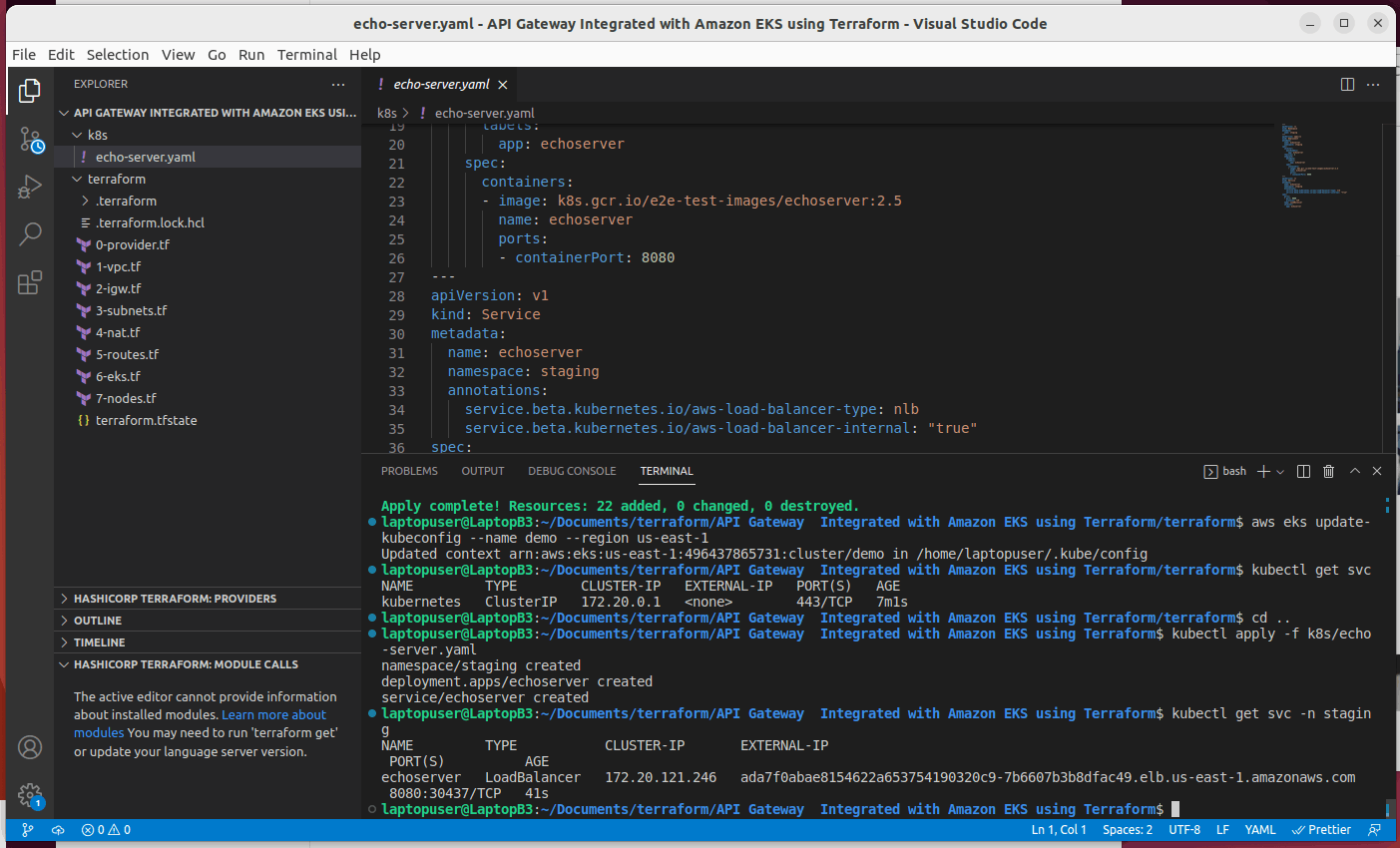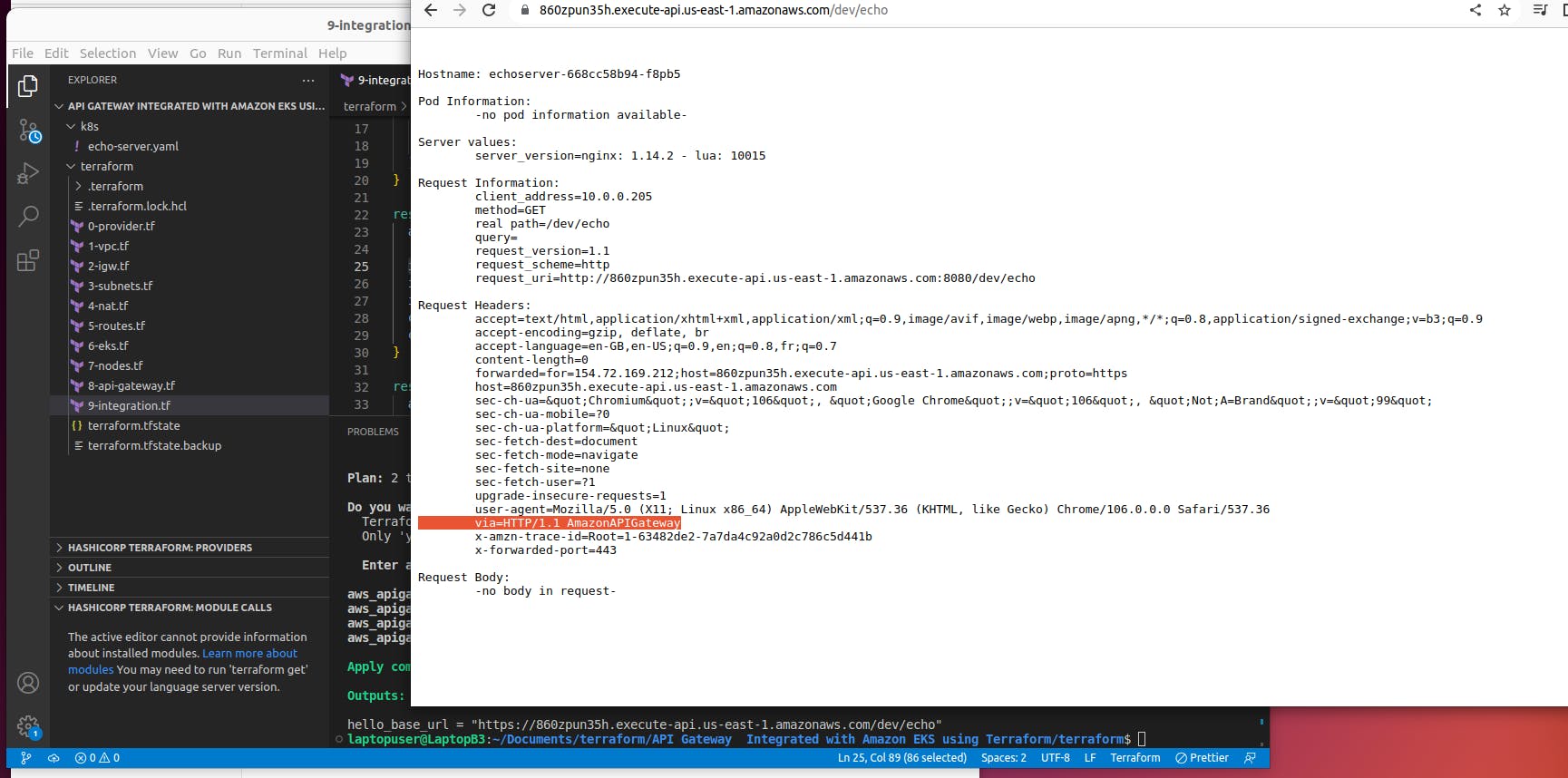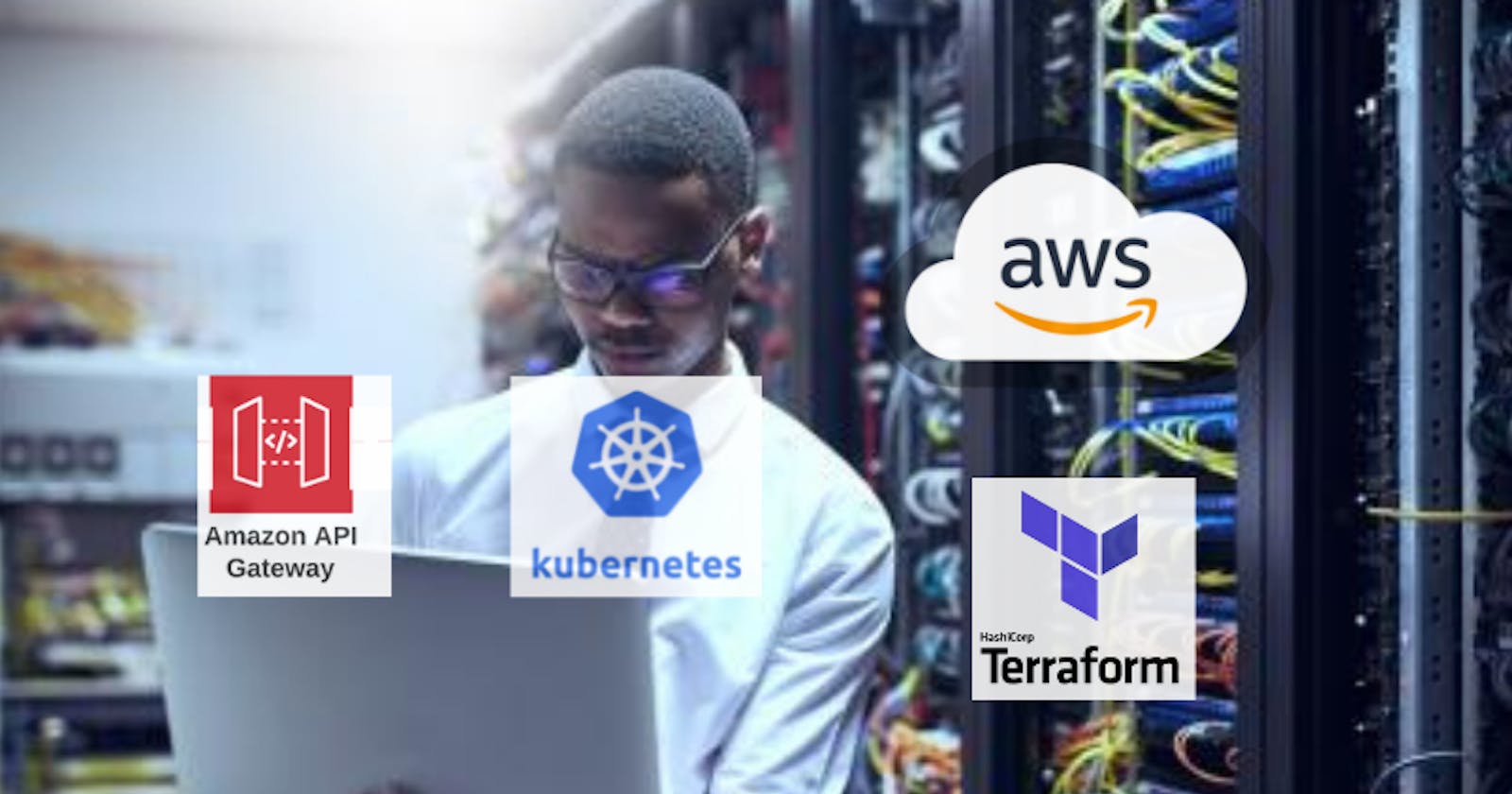Hello readers, in today's article we are going to deploy an application to Kubernetes in AWS and access it via AWS API Gateway.
First, we will create AWS VPC and EKS Cluster Using Terraform. Then we will deploy a simple app to Kubernetes and expose it using a private network load balancer. We also need to create an API Gateway using terraform. And finally, I'll show you how to integrate API Gateway with Amazon EKS.
1 - Create EKS Cluster Using Terraform
let's create an EKS cluster and VPC from scratch.
In the provider, we can declare some version constraints as well as some variables such as the EKS cluster name and an EKS version.
terraform/0-provider.tf
terraform {
required_providers {
aws = {
source = "hashicorp/aws"
version = "~> 4.0"
}
}
}
provider "aws" {
region = "us-east-1"
}
variable "cluster_name" {
default = "demo"
}
variable "cluster_version" {
default = "1.22"
}
Then we need a VPC. terraform/1-vpc.tf
resource "aws_vpc" "main" {
cidr_block = "10.0.0.0/16"
tags = {
Name = "main"
}
}
Internet gateway. terraform/2-igw.tf
resource "aws_internet_gateway" "igw" {
vpc_id = aws_vpc.main.id
tags = {
Name = "igw"
}
}
Four subnets, two private and two public. terraform/3-subnets.tf
resource "aws_subnet" "private-us-east-1a" {
vpc_id = aws_vpc.main.id
cidr_block = "10.0.0.0/19"
availability_zone = "us-east-1a"
tags = {
"Name" = "private-us-east-1a"
"kubernetes.io/role/internal-elb" = "1"
"kubernetes.io/cluster/${var.cluster_name}" = "owned"
}
}
resource "aws_subnet" "private-us-east-1b" {
vpc_id = aws_vpc.main.id
cidr_block = "10.0.32.0/19"
availability_zone = "us-east-1b"
tags = {
"Name" = "private-us-east-1b"
"kubernetes.io/role/internal-elb" = "1"
"kubernetes.io/cluster/${var.cluster_name}" = "owned"
}
}
resource "aws_subnet" "public-us-east-1a" {
vpc_id = aws_vpc.main.id
cidr_block = "10.0.64.0/19"
availability_zone = "us-east-1a"
map_public_ip_on_launch = true
tags = {
"Name" = "public-us-east-1a"
"kubernetes.io/role/elb" = "1"
"kubernetes.io/cluster/${var.cluster_name}" = "owned"
}
}
resource "aws_subnet" "public-us-east-1b" {
vpc_id = aws_vpc.main.id
cidr_block = "10.0.96.0/19"
availability_zone = "us-east-1b"
map_public_ip_on_launch = true
tags = {
"Name" = "public-us-east-1b"
"kubernetes.io/role/elb" = "1"
"kubernetes.io/cluster/${var.cluster_name}" = "owned"
}
}
NAT Gateway to provide internet access for private subnets. terraform/4-nat.tf
resource "aws_eip" "nat" {
vpc = true
tags = {
Name = "nat"
}
}
resource "aws_nat_gateway" "nat" {
allocation_id = aws_eip.nat.id
subnet_id = aws_subnet.public-us-east-1a.id
tags = {
Name = "nat"
}
depends_on = [aws_internet_gateway.igw]
}
Routes. terraform/5-routes.tf
resource "aws_route_table" "private" {
vpc_id = aws_vpc.main.id
route {
cidr_block = "0.0.0.0/0"
nat_gateway_id = aws_nat_gateway.nat.id
}
tags = {
Name = "private"
}
}
resource "aws_route_table" "public" {
vpc_id = aws_vpc.main.id
route {
cidr_block = "0.0.0.0/0"
gateway_id = aws_internet_gateway.igw.id
}
tags = {
Name = "public"
}
}
resource "aws_route_table_association" "private-us-east-1a" {
subnet_id = aws_subnet.private-us-east-1a.id
route_table_id = aws_route_table.private.id
}
resource "aws_route_table_association" "private-us-east-1b" {
subnet_id = aws_subnet.private-us-east-1b.id
route_table_id = aws_route_table.private.id
}
resource "aws_route_table_association" "public-us-east-1a" {
subnet_id = aws_subnet.public-us-east-1a.id
route_table_id = aws_route_table.public.id
}
resource "aws_route_table_association" "public-us-east-1b" {
subnet_id = aws_subnet.public-us-east-1b.id
route_table_id = aws_route_table.public.id
}
Then the EKS cluster itself. terraform/6-eks.tf
resource "aws_iam_role" "eks-cluster" {
name = "eks-cluster-${var.cluster_name}"
assume_role_policy = <<POLICY
{
"Version": "2012-10-17",
"Statement": [
{
"Effect": "Allow",
"Principal": {
"Service": "eks.amazonaws.com"
},
"Action": "sts:AssumeRole"
}
]
}
POLICY
}
resource "aws_iam_role_policy_attachment" "amazon-eks-cluster-policy" {
policy_arn = "arn:aws:iam::aws:policy/AmazonEKSClusterPolicy"
role = aws_iam_role.eks-cluster.name
}
resource "aws_eks_cluster" "cluster" {
name = var.cluster_name
version = var.cluster_version
role_arn = aws_iam_role.eks-cluster.arn
vpc_config {
subnet_ids = [
aws_subnet.private-us-east-1a.id,
aws_subnet.private-us-east-1b.id,
aws_subnet.public-us-east-1a.id,
aws_subnet.public-us-east-1b.id
]
}
depends_on = [aws_iam_role_policy_attachment.amazon-eks-cluster-policy]
}
Single node group with one node. terraform/7-nodes.tf
resource "aws_iam_role" "nodes" {
name = "eks-node-group-nodes"
assume_role_policy = jsonencode({
Statement = [{
Action = "sts:AssumeRole"
Effect = "Allow"
Principal = {
Service = "ec2.amazonaws.com"
}
}]
Version = "2012-10-17"
})
}
resource "aws_iam_role_policy_attachment" "amazon-eks-worker-node-policy" {
policy_arn = "arn:aws:iam::aws:policy/AmazonEKSWorkerNodePolicy"
role = aws_iam_role.nodes.name
}
resource "aws_iam_role_policy_attachment" "amazon-eks-cni-policy" {
policy_arn = "arn:aws:iam::aws:policy/AmazonEKS_CNI_Policy"
role = aws_iam_role.nodes.name
}
resource "aws_iam_role_policy_attachment" "amazon-ec2-container-registry-read-only" {
policy_arn = "arn:aws:iam::aws:policy/AmazonEC2ContainerRegistryReadOnly"
role = aws_iam_role.nodes.name
}
resource "aws_eks_node_group" "private-nodes" {
cluster_name = aws_eks_cluster.cluster.name
version = var.cluster_version
node_group_name = "private-nodes"
node_role_arn = aws_iam_role.nodes.arn
subnet_ids = [
aws_subnet.private-us-east-1a.id,
aws_subnet.private-us-east-1b.id
]
capacity_type = "ON_DEMAND"
instance_types = ["t3.small"]
scaling_config {
desired_size = 1
max_size = 5
min_size = 0
}
update_config {
max_unavailable = 1
}
labels = {
role = "general"
}
depends_on = [
aws_iam_role_policy_attachment.amazon-eks-worker-node-policy,
aws_iam_role_policy_attachment.amazon-eks-cni-policy,
aws_iam_role_policy_attachment.amazon-ec2-container-registry-read-only,
]
# Allow external changes without Terraform plan difference
lifecycle {
ignore_changes = [scaling_config[0].desired_size]
}
}
Now let's create that VPC and a cluster using terraform apply command. As always, when you use terraform to create a cluster, you need to update your Kubernetes context manually.
terraform init
terraform apply
aws eks update-kubeconfig --name demo --region us-east-1
kubectl get svc
2 - Deploy App to Kubernetes and Expose It with NLB
Next, we need to deploy an app to Kubernetes and expose it with Network Load Balancer. You don't need to deploy the AWS Load balancer controller for that; you can just use annotations.
We're going to deploy this app to the staging namespace. This deployment is based on a simple echoserver that was built for debugging purposes. And service to expose this app to other applications and services only within our VPC. By default, Kubernetes creates a classic load balancer to change it to a network load balancer use "nlb" annotation. Also, since we will integrate this service using aws private link with API Gateway, we don't need to expose it to the internet.
---
apiVersion: v1
kind: Namespace
metadata:
name: staging
---
apiVersion: apps/v1
kind: Deployment
metadata:
name: echoserver
namespace: staging
spec:
selector:
matchLabels:
app: echoserver
replicas: 1
template:
metadata:
labels:
app: echoserver
spec:
containers:
- image: k8s.gcr.io/e2e-test-images/echoserver:2.5
name: echoserver
ports:
- containerPort: 8080
---
apiVersion: v1
kind: Service
metadata:
name: echoserver
namespace: staging
annotations:
service.beta.kubernetes.io/aws-load-balancer-type: nlb
service.beta.kubernetes.io/aws-load-balancer-internal: "true"
spec:
ports:
- port: 8080
protocol: TCP
type: LoadBalancer
selector:
app: echoserver
Let's go ahead and apply this app.
kubectl apply -f k8s/echo-server.yaml
If you get services in the staging namespace, you should find the hostname of the load balancer, take a note, or copy it.
kubectl get svc -n staging

3 - Integrate API Gateway with Amazon EKS
Now create AWS API Gateway Using Terraform. We're going to be using API version 2. terraform/8-api-gateway.tf
resource "aws_apigatewayv2_api" "main" {
name = "main"
protocol_type = "HTTP"
}
resource "aws_apigatewayv2_stage" "dev" {
api_id = aws_apigatewayv2_api.main.id
name = "dev"
auto_deploy = true
}
Go back to the terminal and apply it.
terraform apply
Integrate API Gateway with Amazon EKS
The final step is to integrate API Gateway with Amazon EKS. For integration, we need to create AWS private link, but before, we need to create a security group. We need to use the HTTP_PROXY type. For the integration method, you can specify HTTP methods such as GET/POST or allow all of them. The connection type is VPC_LINK, and specify the name of that link itself.
For integration URI, we need to specify the load balancer listener arn. You can find it in the aws load balancer section under listeners. Copy this long id and use it for URI.

The final resource that we need to declare is the route for API Gateway. You need to specify the api gateway id. Then the HTTP method and URL path, and finally, the integration id of the load balancer listener.
terraform/9-integration.tf
resource "aws_security_group" "vpc_link" {
name = "vpc-link"
vpc_id = aws_vpc.main.id
egress {
from_port = 0
to_port = 0
protocol = "-1"
cidr_blocks = ["0.0.0.0/0"]
}
}
resource "aws_apigatewayv2_vpc_link" "eks" {
name = "eks"
security_group_ids = [aws_security_group.vpc_link.id]
subnet_ids = [
aws_subnet.private-us-east-1a.id,
aws_subnet.private-us-east-1b.id
]
}
resource "aws_apigatewayv2_integration" "eks" {
api_id = aws_apigatewayv2_api.main.id
integration_uri = "arn:aws:elasticloadbalancing:us-east-1:496437865731:listener/net/ada7f0abae8154622a653754190320c9/7b6607b3b8dfac49/325a2c17ddd9e737"
integration_type = "HTTP_PROXY"
integration_method = "ANY"
connection_type = "VPC_LINK"
connection_id = aws_apigatewayv2_vpc_link.eks.id
}
resource "aws_apigatewayv2_route" "get_echo" {
api_id = aws_apigatewayv2_api.main.id
route_key = "GET /echo"
target = "integrations/${aws_apigatewayv2_integration.eks.id}"
}
output "hello_base_url" {
value = "${aws_apigatewayv2_stage.dev.invoke_url}/echo"
}
This is the last time when we run terraform.
terraform apply
Use curl to test integration.
curl https://<your-gw-id>.execute-api.us-east-1.amazonaws.com/dev/echo
Alright, it works; we were able to access the application running in the Kubernetes cluster via API Gateway and a Private link.

Thank you for readings if you want more articles like this, subscribe,
